|
EUREKA! GLIDE 51 LANTERN/FLASHLIGHT
TEST SERIES BY CHAD POINDEXTER
LONG-TERM REPORT
INITIAL REPORT - March 06, 2010
FIELD REPORT - June 05, 2010
LONG TERM REPORT - August 08, 2010
TESTER INFORMATION
|
NAME:
|
Chad Poindexter
|
|
EMAIL:
|
stick1377 (AT) gmail (DOT) com
|
|
AGE:
|
33
|
|
LOCATION:
|
Corinth, Alcorn County, Mississippi, USA
|
|
GENDER:
|
M
|
|
HEIGHT:
|
5' 10" (1.78 m)
|
|
WEIGHT:
|
200 lb (90.70 kg)
|
I am a fairly new hiker and have hiked in the Great Smoky Mountains National Park, on the Appalachian Trail in Georgia, and at a few state parks in Mississippi, Tennessee, and Alabama. I initially obtained slightly heavy gear, however, I am currently making efforts to go lighter. I love my tent and appreciate a warm drink in the morning, as well as a warm meal at night. So far my distance has averaged around 10 mi (16 km) per day, depending on terrain. My wife or my son typically tag along with me on my hikes.
INITIAL REPORT
PRODUCT INFORMATION & SPECIFICATIONS

Manufacturer: Eureka!
Year of Manufacture: 2010
Manufacturer's Website: www.eureka.com
MSRP: (US) $ 39.99
Listed Weight With Batteries: 3.9 oz (111 g) ~ Verified Accurate
Measured Weight Without Batteries: 2.7 oz (77 g)
Listed Run Time: 12 Hours
Battery Type: 3 AAA 1.5V Alkaline
Listed Dimensions / Flashlight Mode: 1.3 in x 4 in (3.3 cm x 10.2 cm) ~ Verified Accurate
Listed Dimensions / Lantern Mode: 1.3 in x 5 in (3.3 cm x 12.7 cm) ~ Verified Accurate
LED Type: 1 x Luxeon Rebel 90 White LED
Listed Lumen Output: Up to 51 Lumens
Housing: Telescopic Expanding Anodized Aluminum with Knurled Tail Cap
IPX Rating: 4 (Waterproof Rating. For more info go here: IPX Rating Scale)
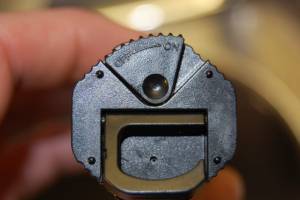 The Eureka! Glide 51 LED Lantern / Flashlight (hereafter referred to as the "light" or "lantern") is designed to be used in a wide variety of settings. The Eureka! Glide 51 light is marketed as a small, light-weight flashlight or lantern that runs off of 3 AAA batteries. The anodized aluminum housing gives the light exceptional strength and durability while the knurled design makes it easy to hold onto, even in wet and / or slippery situations. However, the flashlights versatility allows it to be used in more ways than one; for those times that I need both of my hands I can either set the flashlight up in a vertical position and transform it into a lantern by simply telescoping the head out, or for those times in my tent I can simply hang it from the ceiling using the folding polymer C-hook located in the flashlights base to really shed some light (as seen in picture to left). The light is turned on and off by toggling the lever style switch also located on the bottom of the light (also seen in the picture to left). The Eureka! Glide 51 LED Lantern / Flashlight (hereafter referred to as the "light" or "lantern") is designed to be used in a wide variety of settings. The Eureka! Glide 51 light is marketed as a small, light-weight flashlight or lantern that runs off of 3 AAA batteries. The anodized aluminum housing gives the light exceptional strength and durability while the knurled design makes it easy to hold onto, even in wet and / or slippery situations. However, the flashlights versatility allows it to be used in more ways than one; for those times that I need both of my hands I can either set the flashlight up in a vertical position and transform it into a lantern by simply telescoping the head out, or for those times in my tent I can simply hang it from the ceiling using the folding polymer C-hook located in the flashlights base to really shed some light (as seen in picture to left). The light is turned on and off by toggling the lever style switch also located on the bottom of the light (also seen in the picture to left).
INITIAL IMPRESSIONS

The Eureka! Glide 51 LED Lantern is a metallic green colored octagonal-shaped light and comes packaged inside a hard plastic case (as seen in the picture above). Wrapped in the case are the flashlight (positioned in the lantern mode), 3 Duracell Coppertop AAA alkaline batteries, a flat, black nylon strap that doubles over measuring 7.5 in (19 cm) which creates a carrying loop as well as a single carabiner-style clip. Also included is a double sided informational card which includes the name and products general description on the front and the specifications and operating instructions in both English and Spanish on the back (as seen in picture below left). There is also a pictured diagram with some descriptions located on the back of the package.

Upon opening the flashlight the first thing I noticed was the size of the flashlight. The flashlight is just slightly larger than a roll of quarters which makes the light just the right size to fit comfortably inside my hand when made into a fist. On the other hand, the knurled design enables a steadier, more firm grip when holding the flashlight between the thumb and pointer and middle finger (such as when holding a telescope).
The next thing I noticed is the weight. Without the batteries the flashlight feels nearly weightless, like a toy. So I decided to figure out how to insert the batteries so that I could see the light in action. To change / insert the batteries the base of the light twist 1/8th of a turn. To make things easier there is a white line on the shaft of the light that lines up with the words "open" or "close" which is located on the base. Simply line them up to which ever option is necessary. Once opened the 3 AAA batteries can then be inserted into the shaft of the light. Care must be taken as 2 of the batteries must be inserted with the "+" side up and the 3rd battery with the "-" side up. To help with this there are diagrams on the walls inside the battery housing to show proper insertion of batteries.
Now that the batteries were in I noticed a significant difference in weight, even though it was only slightly over 1 oz (28.35 g) heavier. With the batteries inserted a great deal of weight was now in the middle of the light which made the entire light feel quite a bit heavier.

Now it was time for the real test, so I turned the light on. Since it was still daytime it was hard to see the complete brilliance of light being produced by the single LED, so I shined it in my eyes, and it was bright! I took the flashlight to the bathroom, closed the door and turned it off and on trying to get an idea at its effectiveness. I was impressed with the light that it emitted, but it was still hard to tell its complete output since I was in a small room with lots of reflective surfaces. Here I also set the light on the counter and converted it to lantern mode (which is seen in picture to right). Also, upon turning the light on I immediately noticed the ease of toggling the on / off switch while holding the light in my hand while made into a fist. If held with the toggle switch facing down towards the webbing between my thumb and pointer finger I can easily manipulate the switch with my thumb to turn the light off and on.
Next I slid the telescoping head out to transform the flashlight into lantern mode and noticed that the head telescoped back and forth rather easily. (I also noticed I could feel air coming out the back of the light when telescoping back in to flashlight mode; it was the same feeling as sliding a plunger back and forth in a syringe.) The head telescopes out 1 in (2.54 cm) which exposes a clear plastic housing that surrounds the LED light giving it the ability to function as a lantern (as seen in the picture to right).
Also located on the bottom of the light is a folding "C" shaped clamp which allows the light to be hung facing down. The clamp fits flush with the bottom of the light and slightly locks when folded down so that it will not swing back and forth unwarranted. When folded out the clamp feels quite sturdy, well enough to easily and fully support the weight of the flashlight while hanging.
The flashlight is stated at having an IPX rating of 4, which according to the IEC 529 European (ECC) Water Protection Specifications is stated as "Protected against splashing water - Same as IPX-3 but water is sprayed at all angles." To clarify this, according to the specifications listed on the packaging material that came with the light, this flashlight is waterproof.
MY THOUGHTS
I like the light so far. It is different from other flashlights that I used which were typical flashlights. The Eureka! Glide 51 light transforms.
I have a little concern about the way the base comes off to replace the batteries. It can be a little tricky to line the base back up to reattach the base to the light. I find that I have to play with it just a little to make sure it is lined up exactly right and I have to use a little force to twist the base back on completely.
Also, I have some concern that the packaging states the run time for the light is 12 hours. For 3 batteries this time frame seems a little short to me as compared to other lights that I have used which uses the same amount and size batteries.
Also to note here, according to the website the flashlight runs off of 2 AAA batteries, however, the website states that the light comes with 3 AAA batteries. When the flashlight came in I realized that it did actually run off of 3 AAA batteries instead of 2.
One other note on batteries is that while the packaging material does state that the battery type is "3 x 1.5V AAA Alkaline," it does not state on the website or within the instructions that came with the flashlight (that I could find) not to use lithium style batteries. I say this because lithium batteries could prolong the time frame for the light to work as well as make the overall weight slightly less. I have plans on contacting Eureka! with this question.
Other than this I am very happy with this light and am looking forward to taking the light out for a real test!
FIELD REPORT
FIELD LOCATIONS AND CONDITIONS
I carried the Eureka! lantern with me on an overnight car camping trip about a month ago and used the lantern to light up the area around the campsite while we were out and about, and then under my tarp as we were calling it a night. The temperatures were right around 80 F (27 C) as the sun was going down, then the temperatures dropped to around 60 F (16 C) during the night. There was rain forecast for the night, but it never came. The elevation here at the campsite was around 450 ft (137 m).
This past weekend I carried the lantern with me again on a backpacking trip to Cheaha State Park in Alabama. Temperatures were around 90 F (32 C) during the day and then dropped to near 60 F (16 C) during the night. There were thunderstorms off and on throughout the trip which got bad enough to the point of us leaving early from the trip. The lantern was used under my tarp again while here. Elevations at the State Park were between 750 to 2100 ft (229 to 640 m). Due to our early departure we were only able to use the light for one night on this trip as well.
I have set up my tarp and tent in the back yard and clipped the light under it to get an idea of the light it produced. Here is a picture of the kids playing under the tarp during the night with the light on in lantern mode.
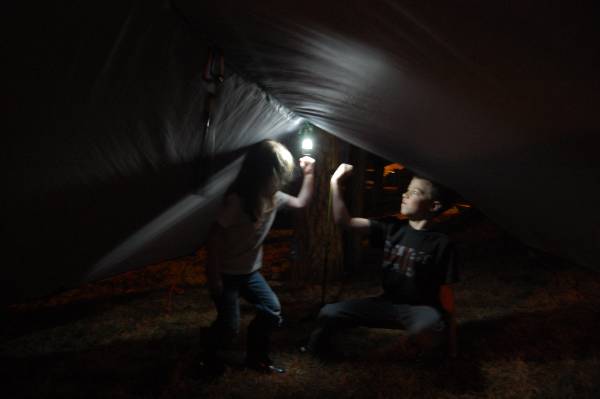
As well, I have used the lantern at home enough to have changed the batteries four times since its arrival. I use it to read at night.
PERFORMANCE IN THE FIELD
The most use that I have gotten out of the light in the field was during the night I used it for car camping. I hung the light in lantern mode from a rope tied between two trees to light up the area where we were sitting once it got dark. With a fresh set of batteries and hanging about 10 ft (3 m) above the ground, the lantern did well to illuminate an area about 25 ft (8 m) wide. We only used the lantern in this manner for about an hour and a half before we took it down and during this time the light did not appear to dim at all. After this, I then hung the light (again in lantern mode) under my tarp while my son and I got ready to call it a night. The clip on the end of the light served well for this, making it very easy to hook around the string which was running end-to-end under the tarp, and easy enough to unhook if needed.
I did not really use the light much in the flashlight mode during this trip, but I did try it out just to see how well it did. Again, I put a fresh set of batteries inside the light when starting this trip out. In the flash light mode, the light did a very good job at illuminating whatever it was pointed at up to a distance of around 30 ft (9 m). The beam on this light is a straight beam and pretty well focused on what it is directed at, but it did throw some light around the main beam, allowing a somewhat wider field of vision.
On the most recent trip at Cheaha State Park, I did not get to use the light while outside the tarp since the rain forced us under the tarp just as the sun was going down. As it got later in the night and the skies grew darker, I turned the light on in lantern mode and used the clip to hang it from the ceiling of the tarp. The lantern provided enough light so that we could maneuver around under the tarp and see what we were doing, however, I did notice that with the tarp pitched low (for rain) the light did not seem to light the area as well as if it were hung higher. In the lantern mode, not much light is directed beneath the light, so if the lantern is hung low to the ground, the light does not seem as efficient.
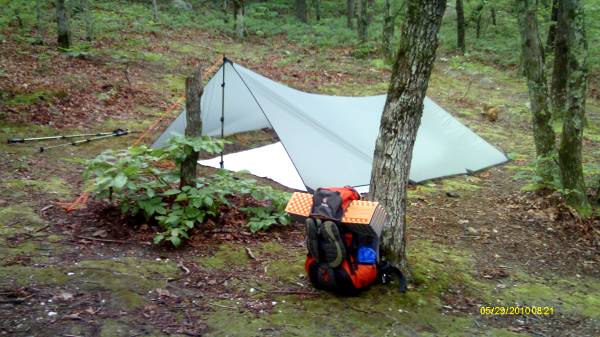 | | At Cheaha State Park |
I have grown fond of the Eureka! Glide 51 Lantern over the last few months. It seems to be a solid little light, and has some nice features. By this, I mean the ability to be used as a flashlight as well as a lantern, but most importantly that the light features a built in clip. The lantern packs very easily in that it can fit just about anywhere in my pack. I also really like the way it fits in my hand when using it in the flashlight mode.
One problem I seem to be having quite often is locating the on / off switch. It is hard to find while in the dark, and when I am rubbing my thumb or finger around the bottom of the light searching for the switch, I seem to have a hard time catching it. It would be nice if the switch stood out somehow to make it easier to feel for it in the dark.
Also, I do not consider the battery life to be great considering the lantern uses three AAA batteries. I have changed the batteries four times in the light since I received it. This is mainly due to me using the light to read at nights, and night after night at about 30 minutes to an hour at a time eats the batteries up pretty quick. Each time that I changed the batteries out the light was not completely dead, but it was dim enough to make reading difficult. At this rate, I would feel safe using this light with a fresh set of batteries for about four nights, however, if I were to be out longer than this I would want to know that I had a fresh set of batteries with me. I did contact the company through email and asked about using lithium batteries in this lamp and Eureka! responded saying that they do not suggest using lithium batteries in the Glide 51 light. (Bummer.)
I have not been able to get much outdoor experience with the light up to this point, but as of right now I have another five nights of backpacking trips and car camping planned within the next three weeks in which I will get to use the light on, and I am looking forward to using it.
LONG-TERM REPORT
LONG-TERM TEST LOCATIONS AND CONDITIONS
PINEY GROVE CAMPGROUNDS: During the first week of June the family and I spent two nights at the Piney Grove Campgrounds. We hung the lantern from the inside of our new large family tent in lantern mode both of those nights. We were camped right next to a large lake so with the 90 F (32 C) and above temperatures it was quite hot and humid. The night time temperatures did not offer much relief since the temperatures were still right at 80 F (27 C). However, we did have a fan blowing inside the tent circulating the air. I believe the elevation at the campsite is around 400 ft (122 m).
GREAT SMOKY MOUNTAINS NATIONAL PARK: My son and I headed to the Great Smoky Mountain National Park for two nights on the third weekend in June. Temperatures here on top of the mountains were much better, with highs around 78 F (26 C) during the day and as low as 55 F (13 C) at night. However, on top of the mountains we did encounter frequent rain showers. Our hike started us at an elevation of 3,830 ft (1,170 m) and we topped out at 6,593 ft (2,010 m) just a few miles down the trail. Both nights we stayed in shelters and the Eureka light served as a lantern at times and as a flashlight at others.
PICKWICK LANDING STATE PARK CAMPGROUNDS: On the weekend of July 4th, my wife and I took off with a few friends for two more nights out at the river. The temperatures here were as high as 97 F (36 C) during the day, and again did not cool off much with lows around 80 F (27 C) at night. We did not receive any rain; however, with the high temperatures and the close proximity of the running river, the general conditions were a bit humid. Elevations at the Pickwick campgrounds are 420 ft (128 m).
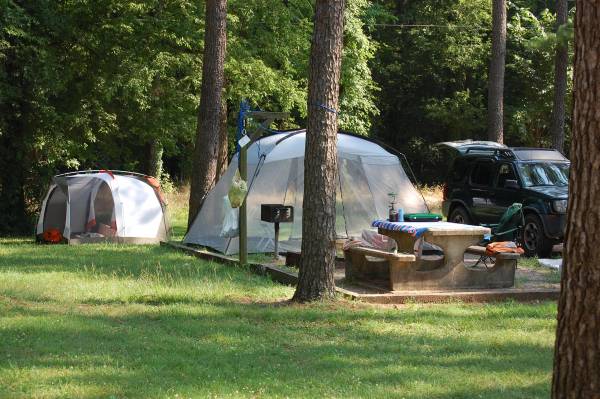 | | At Pickwick Landing State Park Campground |
Other than these times I have continued to use the Eureka light at nights before I go to bed to read with. However, I have been quite busy over the last few weeks so I have not used it as much lately. I have used it maybe once or twice a week, and a couple of times have not used it at all during the week.
PERFORMANCE IN THE FIELD
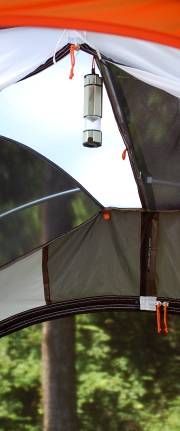 | | Just hangin' around |
I put a fresh set of Energizer batteries in the Eureka light in June, right before my first camping trip mentioned above (Piney Grove Campgrounds). I have not changed the batteries out since then; however, it is now time to do so. One of my concerns when I first started this test series was battery life. I thought it was quite short considering the light requires 3 AAA alkaline batteries and has a listed burn time of 12 hours. What I have come to find out over the last few months is that the listed time is pretty accurate; however, I have found that the quality of the actual light does vary with the brand of batteries used. I have used some of the cheapest batteries I could find to use in the light and with these batteries, the amount of light quickly began to decrease. However, with some of the Energizer batteries, the light seems to remain bright for a longer period of time before the light begins to dim. Overall, in my experience, the batteries do need to be changed out around the 12th hour of use for optimal lighting. Around this point in time, the light is bright enough for me to be able to see directly in front of me, but not quite bright enough for me to focus on the words in a book to read very well. I would really like to see how well this light would function on three lithium batteries; however, this is not recommended by Eureka.
I must say that I have enjoyed the multi-functions of the Eureka light. The light is very handy since it serves in more than one way, which is great of any piece of backpacking gear. As a flashlight, it fits very comfortably in my hand and with good batteries loaded up, it will shine far enough in advance for me to make my way safely to the privy in the backwoods during the middle of the night. As a lantern, the built in hook allows the lantern to hang virtually anywhere. And thanks to the open-hook design I do not have to fuss with tying or untying knots to place or remove the lantern. However, the actual light which is produced while in lantern mode is variable. With fresh batteries, the lantern lit up our large and roomy four person tent well enough for everyone to do basically what was needed to be done. However, hanging nearly 6 ft (1.8 m) from the floor, I do not feel that there was enough light to adequately read a book with normal size printing. This still did not stop me from bringing the very handy Eureka Light on any of my camping trips though! (And this light will continue to go with me on any of my future trips.)
I believe that when the lantern is telescoped out, the light which is output from the single LED light is actually dimmed by both the actual head of the light as well as the clear plastic globe. This also makes me wonder if the light would shine brighter if the globe was made of glass rather than plastic. The reason I say this is because another single LED flashlight I have will shine much brighter than this one, however in "lantern" mode the LED is not covered by anything, and the light seems to shine much brighter as well as light up the surrounding area much better.
The biggest hang up that I have with the Eureka! Glide 51 light is the on / off switch. When I first received the light I thought it was a great design. What I have learned over time is that it can be a pain in the tail to find the switch in the dark. Rubbing my thumb around on the bottom of the light doesn't necessarily work like I had initially thought it would, unless I happen to get lucky and switch the light off or on. I even have trouble finding the switch at night when the light is on (the light will not light up the back of the flashlight) in order to turn it off! I would like to see the switch slightly longer so that the switch actually jutted out from the side of the flashlight, at least a little bit. However, this would take away a small portion of the sleek design, but in my opinion it would make it more user-friendly.
SUMMARY
Overall, this light has its ups and its downs, but I think the ups have it for me. What really gets me is the way the light fits inside my hand, and I love the design and the function of the hook. These two features are the best part of the light in my opinion, as well as make the light worthy of hanging around in my backpack for a while longer. The other things about the light I can live with.
LIKES
1. The built-in clip.
2. The way the light fits in my hand while in flashlight mode.
3. Can be used as a lantern or a flashlight.
4. The light produces adequate lighting.
DISLIKES
1. The on / off switch can be hard to find.
2. The battery life is kind of short.
3. It would be nice if I could use lithium batteries in this light.
At this time I would like to extend my thanks to Eureka! as well as Backpackgeartest.org for giving me the opportunity to test the Glide 51 Lantern. It has been enlightening!
SIGNATURE

Chad Poindexter
"Stick"
This report was created with the BackpackGearTest.org Report Writer Version 1.5
Copyright 2010. All rights reserved.
Read more reviews of Eureka gear
Read more gear reviews by Chad G Poindexter
|






